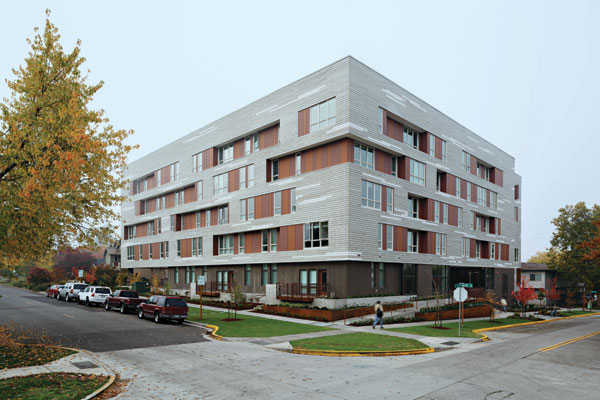Mid-Rise Wood Construction
From a carbon footprint perspective, wood continues to store carbon absorbed during the tree's growing cycle, keeping it out of the atmosphere for the lifetime of the building—or longer if the wood is reclaimed at the end of the building's service life and reused or manufactured into other products. The manufacturing of wood products also results in less greenhouse gas emissions than other materials.2 For example, according to the online Wood Carbon Calculator for Buildings,3 the new Crescent Terminus development, which includes three buildings, each with five stories of wood-frame construction over a concrete podium, has a carbon benefit equivalent to 13,523 metric tons of CO2. This includes 4,327 metric tons of CO2 stored in the wood products and 9,196 metric tons of avoided CO2 emissions.
According to the U.S. Environmental Protection Agency's Greenhouse Gas Equivalencies Calculator, this equates to emissions from 2,583 cars in a year, or from the energy to operate an average home for 1,149 years.4
“Wood is also versatile and adaptable,” says Kam-Biron. “Modifications on the jobsite tend to be straightforward and are easily made.”
When asked how building with wood fits into Crescent Communities' quality mission, Ford cites both sustainability and design flexibility. “With concrete, you can't easily design to have the building pop in and out to create the architectural reveals the way you can with a wood-frame building. We can do a lot more design-wise with wood that we couldn't do with other products. So both our environmental goals and our design goals provided the motivation for [Crescent Terminus] to be a wood-frame building.”
A survey of 227 buildings demolished in Minneapolis/St. Paul found that buildings are often torn down within 50 years, regardless of material, because of changing needs and increasing land values as opposed to performance issues.5 Overall, wood buildings in the study had the longest life spans, showing that wood structural systems are fully capable of meeting a building's longevity expectations. However, when you consider the embodied energy in demolished buildings and the implications of material disposal, the fact that wood is adaptable—either through renovation or deconstruction and reuse (with minimal additional processing)—is a significant advantage.
Mastering Wood Construction Design
As with any type of construction, mastering the technical details of wood-frame construction is critical to creating cost-effective buildings that are safe and durable. Building codes require all building systems to perform to the same level of safety, regardless of material used, and wood-frame structures can be designed to meet or exceed standards for (among other things) fire protection, seismic performance and resistance to high winds.










